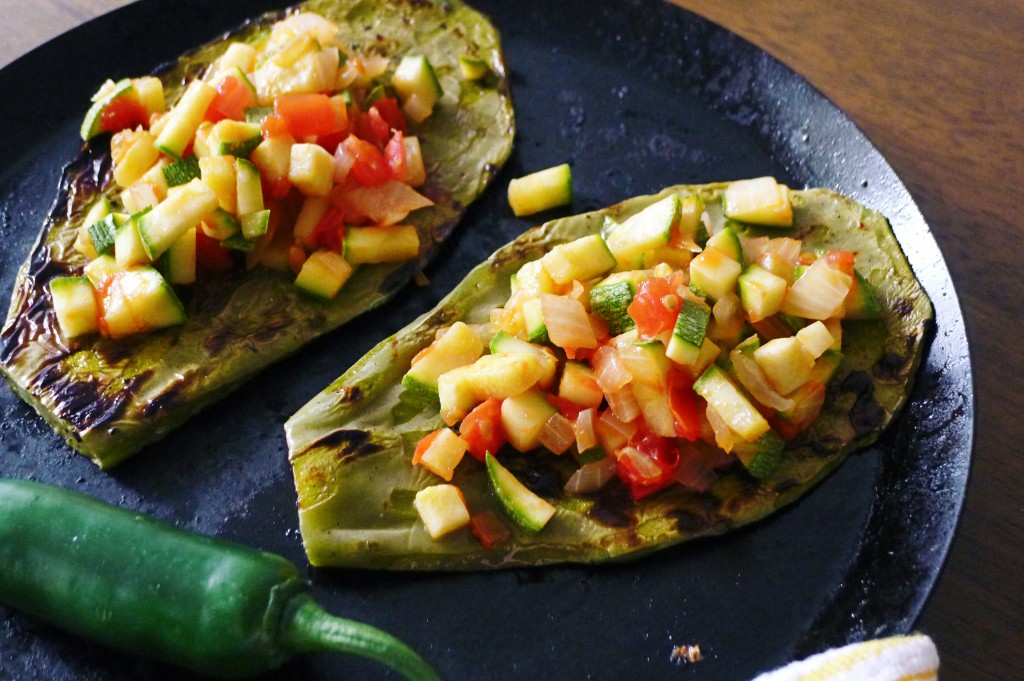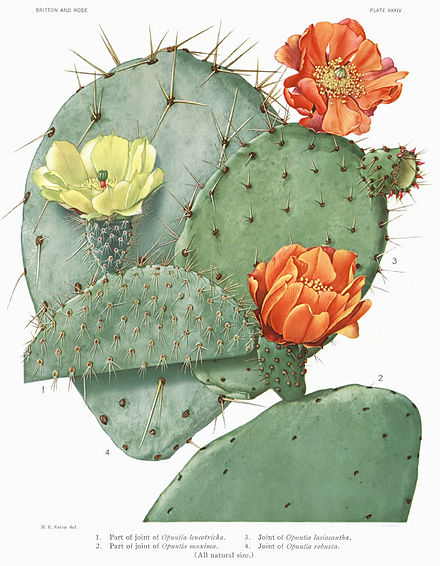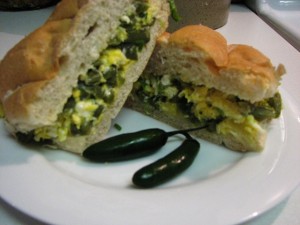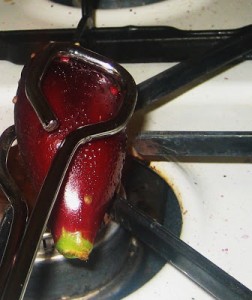Prickly pears are delicious the year-round–as fruits (tuna) and paddles (nopales).
Opuntia ficus-indica
Native range: Long raised for its fruit (tuna in Spanish) and fleshy pads (nopal), the prickly pear cactus, O. ficus-indica, is closely related to wild prickly pears of south and central Mexico, where it was first domesticated.
Invasive range: Given the species’ widespread impact, we include the invasive range in North America and beyond.
North America: California, Arizona, New Mexico, Texas, Florida, Georgia, North Carolina, Puerto Rico, and Hawaii. In North America, this prickly pear is introduced but is not considered widely invasive
Worldwide: Invasive populations can be found in China, Taiwan, Yemen, Eritrea, Ethiopia, Madagascar, Réunion, Somalia, Galapagos Islands, and Australia.
Habitat: Common in disturbed sites, semiarid habitats, coastal dunes, and ledges.
Description: Succulent stems are flat, oval, and segmented. Orange flowers about two inches in diameter. Purple fruits are the size and shape of a fig. Can reach up to 6 feet in height.
As with so many invasive plants: it’s complicated. Opuntia ficus-indica is the most widespread cactus, with the deepest history of domestication. A good crop for dry areas, as it efficiently converts even a little water into biomass, the prickly pear is as vital to the Mexican economy as corn and tequila agave.
DNA analysis has established that this domestic, and invasive, cactus was bred from wild species native to Mexico. It soon spread through the Aztec empire and beyond–cochineal dye, made from a scale insect that lives on cultivated Opuntia was used in Aztec tribute rolls.
After Columbus, ships carried the edible pads, or nopales, to prevent scurvy and to feed the dye insect, distributing the cactus to much of the rest of the world. It became naturalized in the Mediterranean, and many now consider the New World cactus a native. But through much of the Mediterranean, and elsewhere along the old trade routes, it is also considered a pest–it spreads rapidly beyond the zones where it was originally cultivated.
By the early 20th century, cattle ranchers of the Southwest US realized that O. ficus-indica could serve both as feed source and boundary fence. Prickly pears have been used for more than a century to feed the herds; the spines can be burned off to reduce mouth injury. The cactus pads, on which the animals graze, are low in dry matter and crude protein, but useful as a supplement during drought. In addition to food value, the moisture content virtually eliminates the need to water cattle. In Namibia, prickly pears serve as a drought-resistant fodder plant.
In Mexico, Opuntia ficus-indica is cultivated to serve as host plant for the scale insects that produce cochineal dye. The red and purple dye, used by the Aztec and Maya, became one of Mexico’s most valued exports after silver. By the 17th century, it was traded as far off as India, with prices quoted on the London and Amsterdam Commodity Exchanges. The demand for cochineal crashed with the appearance of artificial dyes in Europe in the 19th century.
The most valuable product of O. ficus-indica today is the large, sweet fruit, called tuna in Spanish. It has been introduced and is now grown commercially beyond Mexico’s borders, in Malta, Spain, Italy, Greece, Libya, Tunisia, Morocco, Algeria, Lebanon, Syria, Egypt, Saudi Arabia, Yemen, Israel, Chile, Brazil, Turkey, and Ethiopia.
This fruit, rich in vitamin C, was one of the early cures for scurvy. Typically eaten without the thick outer skin, it tastes like juicy, very sweet watermelon. The bright red-and-purple or white-and-yellow flesh contains many tiny hard seeds, usually swallowed. Native Mexicans ground the seeds for flour, and many North Africans press them for oil. Jams and jellies that resemble strawberries and figs in color and flavor are made from the pulp and juice.
Mexicans have used Opuntia for thousands of years to make an alcoholic drink called colonche. In Sicily, a prickly pear-flavored liqueur called Ficodi is produced. In Malta, a liqueur called Bajtra (the Maltese name for prickly pear) is made from the fruit, which can be found growing wild in most fields.
The fruit was imported from Mexico and the Mediterranean to the United States in the early 20th century by Italian and Greek immigrants. It lost popularity in the ’50s, but regained it in the ’90s, thanks to Mexican immigrants.
Mexican and other Southwestern residents eat the young cactus pads as well, usually picked before the spines harden. Skinned or unskinned, sliced into strips, fried with eggs and jalapeños, and served as a breakfast treat, they have a texture and flavor like string beans.
Harvest
The Traditional Way
Southwest tribal women picked the fruits early in the morning while the glochids, or spines, were still softened by dew. Rubbing the large berries in sand removed the spines.
21st-century Style
Green Deane of eattheweeds.com recommends spraying fruits and pads with water to reduce the number of spines. Pick the fruit with heavy leather gloves, then wash them again and or burn the remaining spines with a butane torch or candle flame.
The soft red fruit can be eaten raw or cooked. The seeds are hard and can be consumed, removed, or ground into flour.
The fleshy pads, or nopales, can be eaten raw or cooked. Wearing heavy gloves, trim off the edge of the leaf, and remove the bumps and thorns with a small knife or a vegetable peeler. Rinse with cold water to remove spines and wash off stick fluid. Use right away or pat dry, cover with plastic wrap, and refrigerate up to two days. Read more about nopales preparation here.
How to prepare prickly pear fruit the Moroccan way.
Recipes
Breakfast Nopales
Adapted from Mexicoinmykitchen.com
2 eggs
2 tbsp. of chopped green onions
2/3 cups of cooked nopales
vegetable oil
salt to taste
Remove spines from the nopales, trim off the edges and rinse. Cut the paddles into small strips. Bring a pot of water (approximately 4 quarts) to a boil, add about 2 tbs of salt. Add the no pales and let boil for about 15 to 20 minutes, which will remove much of the sap from the paddles. Rinse and pat dry or strain.
Heat oil in a frying pan over medium heat.
Add chopped green onions and stir for about one minute.
Add nopales and cook for about 1 or 2 minutes.
Add eggs and cook until they become firm but not dry, stirring as needed.
Add salt to taste.
Serve as is, on bread, or in tacos.
Prickly Pear Jam
Chef Tess provides a nice tutorial on preparing prickly pear fruits for jam here.































